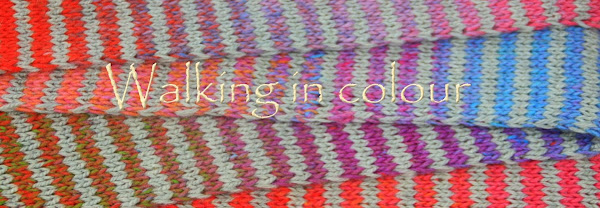Following on from my introduction to substituting yarn found here , in this post I will be guiding you through the process of swatching.
Swatching allows you to measure the gauge of your knitting, that is, how many stitches and rows there are to a given unit of measurement. This is also referred to as a tension square. I prefer the metric system so I use cm but on some yarn labels you may see inches. Most patterns now give gauge for 10 cm but occasionally I have seen stitches per inch or, more commonly, stitches per 4 inches. It is definitely a case of the bigger the better for measuring gauge as this will give you greater accuracy. If you are short of time you may be tempted to measure an inch or a couple of cm (I know I have) but any inaccuracy will be amplified when you knit up your garment which may make a significant difference to the fit. Also, don't be tempted to round up or down your stitch number, if your measured mark falls half way between a stitch, then do your calculations including the half stitch.
Everyone develops their own method of swatching, the following is the way I do it, having tweaked it over the years. I should point out that this method is aimed at producing a swatch in order to measure gauge or tension, swatching to try out different patterns can be any size. For example, a swatch of cables may be long and thin, it is entirely up to you.
Step 1.
Cast on an appropriate number of stitches. If you have a label for your yarn this should show you the gauge, which may be in the form of a grid or as text. Add on 10 or so extra stitches to allow for curled up edges.
The yarn for the label above has a gauge of 22 stitches per 10 cm so 30+ stitches would be a good number to cast on. If you don't have a label to guide you then estimate what you think you will need. Just cast on and keep going until you think you have enough. You will need to do this if you are combining two (or more) strands of yarn.
Step 2.
Knit your swatch to a length 1-2 cm longer than you want to measure. I add a garter stitch border around my swatches to give stability and reduce curling if I am knitting in stocking stitch.
Step 3.
Cast off loosely, then wash and block your swatch. This step is particularly important if you are swatching patterned knitting, such as lace, as your blocked fabric will be a very different size to unblocked. This brings up the point that your swatch should be knitted in the same pattern as the garment design otherwise you will end up with very different results.
Step 4.
Place a ruler or tape measure along the swatch, horizontally, and place a pin at each end of your measuring unit (i.e. 10 cm), through the rows of knitting. Count the number of stitches between the pins.
In the example above I counted 18 1/2 stitches. I find it easier to measure the gauge whilst the swatch is still pinned to my blocking pads. This stops it from moving around and keeps the stitches even. I use large foam pads for blocking (they look like huge jigsaw pieces), I got mine really cheaply from Amazon. I like the flexibility of this system, you can join them together in a long strip for a lace scarf or make a huge square for a jumper.
Step 5.
Now place your ruler or tape vertically and place pins along rows at each end of your measured length. Count the number of rows between the pins.
I counted 29 rows. In the photo below I have used an alternative to a ruler or tape measure. I made a square frame out of cardboard where the internal measurements are 10 cm by 10 cm. It is easy to simply place the square over your swatch and count the stitches and rows. You can make it whatever size you wish, you just have to make sure that your angles are accurate at the four corners.
As you can see, my gauge with this yarn is 18 1/2 stiches and 29 rows to 10 cm, compared to the 22 stitches and 28 rows on the yarn label. Even using a pattern specifically written for this yarn I would end up with a garment the wrong size if I didn't swatch first. In my next post I will be discussing this further. What are the consequences of having a gauge different to the one given in the pattern? Will the garment be too big, or too small? I will have lots of swatches to show you which I hope will demonstrate clearly how gauge affects the size of your finished garment.
Cheerio for now.






No comments:
Post a Comment